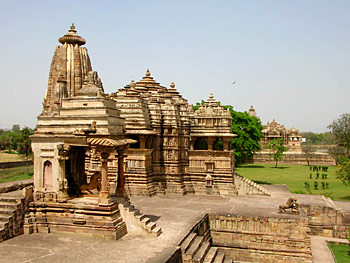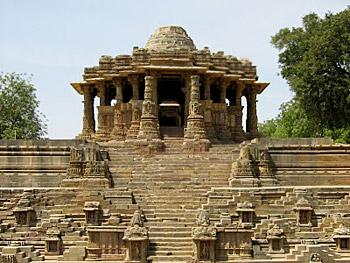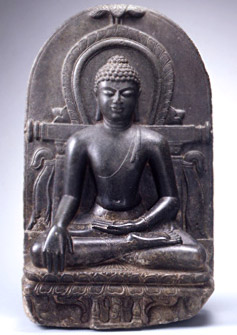 The medieval period begins after the death of Harsha Vardhan in 647 A.D. and ends with the downfall of the Mughal Empire in the eighteenth century. The partial unity of Indian history vanishes with Harsha and it is not restored until the closing years of the twelfth century. During this period India was ruled by many independent dynasties. So far as North India is concerned these dynasties were mainly Rajput. Chalukyas, Hoysalas, Rashtrakutas, Pallavas were the dynasties that ruled South India.
The medieval period begins after the death of Harsha Vardhan in 647 A.D. and ends with the downfall of the Mughal Empire in the eighteenth century. The partial unity of Indian history vanishes with Harsha and it is not restored until the closing years of the twelfth century. During this period India was ruled by many independent dynasties. So far as North India is concerned these dynasties were mainly Rajput. Chalukyas, Hoysalas, Rashtrakutas, Pallavas were the dynasties that ruled South India.
The main Rajput kingdoms in the North were Kashmir, Kannauj, Palas and Senas of Bengal and Bihar, Chandelas of Bundelkhand, Gujarat, Malwa, Delhi and Ajmer. Chalukyas, Pallavas, Hoysalas ruled in Mysore, the Deccan and Tamil Nadu.
Dynasties that Ruled North India
Kashmir was ruled by Karkot dynasty and then by the Utpala dynasty whose great king was Avanti Varman. Great engineering products were undertaken. After the death of Harsha, Kannauj was ruled by Yashovarman. He and his descendants had to suffer defeat at the hands of king Lalitaditya and also the Pala King of Bengal. It was conquered by Pratiharas who had come from the southern Rajputana. Raja Bhoja ruled for half a century and built up an extensive empire including Saurashtra, Awadh and Magadha. Kannauj witnessed a great cultural resurgence under his rule. His son also continued his progressive tradition and patronised the famous poet and dramatist Rajshekhar.
 Some parts of Bengal were said to have been ruled by the Guptas and the Maukharies. Thereafter the Pala dynasty ruled till thirteenth century. Part of Bengal came under the sway of a new dynasty, the Senas in the eleventh century. The Palas were Buddhists while the Senas patronised Brahmanism.
Some parts of Bengal were said to have been ruled by the Guptas and the Maukharies. Thereafter the Pala dynasty ruled till thirteenth century. Part of Bengal came under the sway of a new dynasty, the Senas in the eleventh century. The Palas were Buddhists while the Senas patronised Brahmanism.
Bundelkhand was ruled by the Chandelas who came into prominence in the ninth century when they over-threw the neighbouring Pratihara kingdom. Their kingdom was called Jijhoti and the important towns were Khajuraho, Mahoba and Kalanjar. Khajuraho temples are architecturally very well built.
Gujarat was occupied by the Solanki dynasty and Malwa by the Parmar dynasty. The Solanki dynasty was established by Mulraj in the tenth century A.D. Among the Parmar kings Raja Bhoj was the most renowned who ruled from 1018 AD to 1060 A.D. He was a scholar and a liberal patron of Sanskrit learning.
 Ajmer and Sambhar had been ruled by the Chauhans for centuries. Vigraha-raja was the known king of this dynasty and a noted patron of Sanskrit literature. His brother`s son was Prithviraj who has become famous in Indian history and whose exploits have been the theme of Chandbardai`s epic `Chand Raso.`
Ajmer and Sambhar had been ruled by the Chauhans for centuries. Vigraha-raja was the known king of this dynasty and a noted patron of Sanskrit literature. His brother`s son was Prithviraj who has become famous in Indian history and whose exploits have been the theme of Chandbardai`s epic `Chand Raso.`
Dynasties that Ruled South India
The medieval history of the southern peninsula concerns itself chiefly with two groups of states - the kingdoms of the Deccan plateau lying between River Narmada on the North and the River Krishna and the River Tungabhadra on the south, and the states beyond these rivers.
Mysore was first ruled by the Kadambas from the third century to the sixth century A.D. and then by the Gangas up to the tenth century who later on went to Kalinga, and ruled there till the fifteenth century A.D.
Chalukya dynasty rose to prominence in the early medieval era in the Deccan. Pulakesin I was the king of Badami. In the eighth century the power of the Chalukyas was finally shattered by the Rashtrakutas. The Rashtrakuta dynasty continued to rule for more than two centuries and had commercial relations with the Arabs also. Under the Chalukyas and the Rashtrakutas, Deccan was enriched by many temples among which the rock-cut temple of Kailash is famous. In the Yadavas of Devagiri and Hoysalas of Dorasamudra ruled these regions.
The Hoysalas of Mysore came into prominence in the twelfth century. They erected many temples in their dominion in the twelfth and thirteenth centuries. Halebid is most famous from the architectural view point.
Pallava dynasty came into prominence in the sixth century and their capital was Kanchi. They were the dominant power in the South from the middle of the sixth century to the middle of the eighth century and had extended their rule to Narmada. The Cholas, the Pandyas and the Cheras existed in the Mauryan period. In the medieval period they continued to have a well-established state right till the thirteenth century.



















